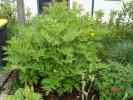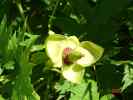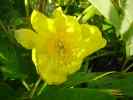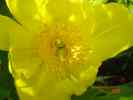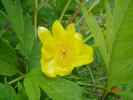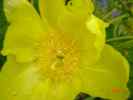Status:
accepted
1997
original description of Hong:
Originalbeschreibung von Hong:
Paeonia ludlowii (Stern & Taylor) Hong, stat. nov. Basionym: Paeonia lutea Delavay ex Franchet var. ludlowii Stern & Taylor, J. Roy. Hort. Soc. 76: 217. 1951. TYPE: China. SE Tibet [Kongbo Prov., Miling, Tsangpo Valley], Ludlow, Sherriff & Taylor 4540 (holotype, BM).
Deciduous and caespitose shrubs, up to 3.5 m tall. Roots attenuate downward, not fusiform. Stems gray, up to 4 cm diam. Leaves biternate, glabrous on both sides, green above, pale glaucous beneath; petiole 9--15 cm long; leaflets 9, leaf blade 12--30 ´ 14--30 cm, lateral 3 leaflets on each side with main petiolules 2--3 cm long, terminal 3 leaflets with main petiolules 5--9 cm long; leaflets nearly sessile, 6--12 ´ 5--13 cm, usually 3-segmented nearly to base; segments 4--9 ´ 1.5--4 cm, mostly 3-lobed to middle; lobes 2--5 ´ 0.5--1.5 cm, entire or with 1 or 2 teeth, segments, lobes, and teeth all acuminate at apex. Flowers 3 or 4 on each shoot, axillary, 10--12 cm across; pedicels slightly curved, 5--9 cm long; bracts 4 or 5 and sepals 3 or 4, grade into one another; petals pure yellow, spreading, obovate, rounded at apex, 5--5.5 ´ 2.5--3.5 cm; filaments yellow, 1.1--1.5 cm long, anthers ca. 4 mm long; disc only 1 mm high, yellow, dentate; carpels mostly single, very rarely 2, glabrous; stigmas yellow. Follicles cylindrical, 4.7--7 ´ 2--3.3 cm. Seeds rounded, dark brown, ca. 1.3 cm diam. Flowering late May to early June.
In their description of Paeonia lutea var. ludlowii, Stern and Taylor (1951, 1953) indicated that the taxon is distinctly different from variety lutea and distinguished it by its long, commonly unbranched stems to 8 feet (vs. to 5 feet in var. lutea), larger and more open flowers, and up to 2 carpels twice as large as those of variety lutea. Upon the examination of plants in five populations in Mailing and Nyingchi counties, as well as five populations of variety lutea (= P. delavayi), these differences have been confirmed. As shown in Figures 1 and 2, plants of P. ludlowii are tall, caespitose, and with larger, pure yellow flowers, yellow filaments, acuminate leaf segments and lobes, and mostly one carpel per flower (more than 97% of the flowers examined have a single carpel and less than 3% have two). Furthermore, P. ludlowii produces very large follicles that contain the largest seeds in the genus. In contrast, plants of P. delavayi are not caespitose and have much shorter stems, acute leaf lobes and segments, more or less pendulous and smaller flowers on curved pedicels, yellow petals nearly always red-blotched at base, purple-red filaments, and 3 or 4 (rarely 2) much smaller carpels. These differences clearly support the recognition of variety ludlowii as a distinct species.
Paeonia ludlowii is a narrow endemic of SE Xizang, where it grows in sparse forests, woods, and thickets in Nyingchi, Mailing, and Lhunze counties at 92.4°--94.8°E and 28.4°--29.9°N. All five populations studied were small in size, and the largest was about 200 m in diameter. Except for the Quenima Village population (Hong et al. H96020), which had only four individuals, the other populations consisted of rather dense individuals, and the species was a dominant element in the community. Two factors may explain the small population size with a large number of individuals. First, this species has a high seed-set, and its seeds appear to have a high germination rate. Nearly 100 seedlings were found in an area of a square meter under a large individual in the Nanyigou population (Hong et al. H96030). Second, the seeds of P. ludlowii are large (ca. 1.3 cm diam.) and are not adapted to long-distance dispersal; perhaps they are mostly moved by rats. The species is obligately sexual, and no vegetatively produced individuals or plantlets have been found in any of the populations. More than 20 small plantlets were dug out, and all were found to be seedlings, a sharp contrast to P. delavayi, which also reproduces vegetatively.
Paeonia ludlowii is a tall shrub that often forms large and dense clumps with dozens of stems. A single individual may have up to 105 flowers (Fig. 2). The species is also a medicinal plant dug out by the local people for its root bark. In three of the five populations studied (Hong et al. H96007, H96014, H96030), hundreds of individuals were dug out by people from Gansu and Qinghai provinces (Fig. 2). This causes a serious threat to the survival of this species. Effective measures must be taken to conserve this beautiful flower.
Paeonia ludlowii is diploid with 2n = 10. The meiotic chromosome count, reported here for the first time, is based on Hong, Luo & Zhang H96007 (PE).
Specimens examined.
CHINA.
SE Xizang: Mailing County: Gangga, 4 km E of Gangga Bridge, 29.3°N, 94.4°E, 2900 m, Hong, Luo & Zhang H96005 (GH/A, K, MO, PE, S); Zhare Township, Caimu Village, N of Yarlung Zangbo (River), 29.2°N, 94.3°E, 2980 m, Hong, Luo & Zhang H96007 (GH/A, K, MO, PE, S); between Gangga and Mailing, S of Yarlung Zangbo (River), 29.2°N, 94.2°E, 3000 m, Hong, Luo & Zhang H96014 (GH/A, K, MO, PE, S), Zheng 22 (Herb. Xizang Plateau Inst. Ecol. Bayi); Nanyi Township, Nanyigou (Valley), 29.2°N, 94.1°E, 2950 m, Hong, Luo & Zhang H96030 (GH/A, K, MO, PE, S), 3300 m, Zheng 673 (Herb. Xizang Plateau Inst. Ecol. Bayi); Regagou, 2870 m, Xizang Inst. Ecol. 186 (Herb. Xizang Plateau Inst. Ecol. Bayi); Lhunze County: Qayu, Zuanbadala, 3450 m, Qinghai- Xizang Expedition 750450 (PE, KUN); Nyingchi County: Bayizhen, Juemugou, 2950 m, Yao, Tang, Zheng & Pan 1005 (Herb. Xizang Plateau Inst. Ecol. Bayi), 3000 m, Zheng 19 (Herb. Xizang Plateau Inst. Ecol. Bayi); Dongjug Township, Quenima Village, 29.9°N, 94.8°E, 3100 m, Hong, Luo & Zhang H96020 (GH/A, K, MO, PE, S).
1999
HONG De-Yuan & PAN Kai-Yu Taxonomical history and revision of Paeonia sect. Moutan (Paeoniaceae) Acta Phytotaxonomica Sinica 37(4):351-368(1999)
Li Jiajue (Ed.) 2005,
Chinese Tree Peony, Xibei, Xinan, Jiangnan Volume
China Forestry Publishing House, 2005. ISBN 7503840404,
Paeonia ludlowii (Stern & Taylor) Hong, [ P. ludlowii (Stern & Taylor) JJ. Li et D. Z. Chen; P. lutea Delavay ex Franch. var. ludlowii Stern et Taylor]
A large deciduous shrub up to 3.5 m tall. Thick fleshy roots attenuated downward to the tip but no expanded ellipsoid. Bark gray-brown and exfoliated. Leaves big, biternate, pinnate, compound. Leaflets 9, glabrous, above green and below gray, almost sessile, mostly 3-partite, then 2-teethed, acuminate at the apex. Flowers 3 or 4 per shoot, terminal and axillary, diam. 10-12cm.
Bracts 4 or 5. Sepals 3 or 4, arranged by size. Petals spreading, pure yellow, occasionally white, obovate, apex rounded. Filaments yellow. Disc fleshy, yellow, papillary. Carpel(s) 1 or 2, glabrous. Stigmas yellow. Follicles cylindric. Seeds big and globose. Flowering late May to early June. Fruit August (Fig. 1-1).
P. ludlowii is distributed in a quite narrow area. The wild species is only found in the Brahmaputra Gorges at altitudes between 3,000 - 3,700 m in SE Tibet. The plants are tall and have large leaves and beautiful flowers (Fig. 1-2). Ludlow and Sherriff brought P. ludlowii to England from Tibet in 1936 and introduced it many times later. Until 1953 P. lutea var. ludlowii was published (Bot. Mag., London, 1953, t. 209). Nowadays, P. ludlowii, as a substitute of P. lutea, has been widely cultivated in Europe and America and used as parent plants in breeding. The resource investigation of this species was done late in China. After investigation from April to May in 1986, Zhang Q.X., from Beijing Forestry University, found a 20 hm2 sized population (pop.) in Milin of 3,100 m in altitude on the south coast of Brahmaputra where P. ludlowii is a dominant species. He also found that this species has only 1 or 2 carpel(s) and blooms 2 or 3 weeks later than P. lutea. Since then, Chen D.Z. et al. of Yuzhong Peace Peony Garden in Gansu investigated and introduced it respectively in 1991 and 1993. Based on the field investigation and the observation of introduced plants, Li JJ. et al. found obvious differences between P. ludlowii and P. lutea in both morphological and ecological characters and took it as a species (Li JJ. et al., 1995). The analyses of karyotype and leave protein also indicated that it was obviously different from P. lutea. Therefore, the classification position of P. ludlowii should be established (Li JJ. etal, 1998). During this period, Hong D.Y. etal also performed the investigation and reported the same viewpoint.


02. June 2000
01. Sept. 2000 1.80x 1.60m
Nov. 2000
ripe fruits/reife Früchte
Wörlitz
in the Park of Woerlitz:

















